Modern infantry outfit and promising developments
Nothing fundamentally new in terms of small weapons the world’s armies are not yet shining. Americans continue to suffer from the M16, although they are already changing their M4 to HK 416, the Germans still use the HK G36 rifles, the French are still running around with their rather controversial, extremely uncomfortable FAMAS ...
Let us consider in order who and what offers its armed forces what to face in the next twenty to twenty five years and what Russia can oppose.
The main "highlight" of the modern soldier’s equipment is the introduction of modern information technologies into the soldiers' equipment, which dramatically increase the information connectivity within the unit and facilitate coordination of military personnel’s actions. Perspective equipment includes communications equipment, navigation systems, night vision devices, laser range finders, electronic maps, as well as personal protective equipment (body armor, helmets, etc.), advanced small arms and uniforms made using thermostatic fabrics, overheating or overcooling.
American Beauty
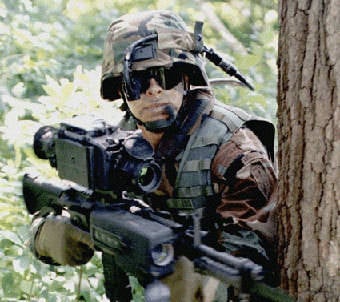 Soldier included Land Warrior. Photo: US ARMY.
Soldier included Land Warrior. Photo: US ARMY.The American program "Land Warrior", which began earlier than others, has now achieved the greatest results. By the 2003, in the United States, two sets of Land Warrior Block 1 and Land Warrior Block 2 were created, the last one designed for soldiers of the Stryker brigade (a new type of formations equipped with Stryker combat vehicles). In 2003, the Land Warrior Block 2 kit was decided to be the main one. Currently, the development of a promising set of equipment, which received a new name - Mounted Warrior, is being carried out by General Dynamics C4 Systems.
Mounted Warrior Kit includes: computer, helmet display (HMD), GPS-navigator, radio station, power supply and weapon control system. The soldier can monitor the battlefield thanks to video and infrared cameras mounted on an automatic rifle, the image of which is displayed on the display. At the same time the soldier himself can remain in the shelter. In addition to the HMD, the helmet is equipped with a monocular optical system, headphones and a microphone. The entire unit, together with the Stryker armored vehicles, is integrated into a single information system. Combat vehicles serve not only for the transportation of soldiers and fire support, but also as a kind of "information nodes" of the "battle space" (battlespace), ensuring the exchange of information between different units.
From May to September, 2006, based on the 4 Brigade of the 23 Infantry Division (Fort Lewis, W.), conducted the first field tests of the 440 kits of Mounted Warrior and XountedUMNs. According to the results of tests in February 147, the Pentagon announced the possible closure of the program due to its low efficiency due to the lack of necessary technologies.
However, in June 2007, the 4 Brigade was sent to Iraq, along with the 200 combat kits of Land Warrior and Mounted Warrior. Kits were tested during patrols in urban environments and in the desert.
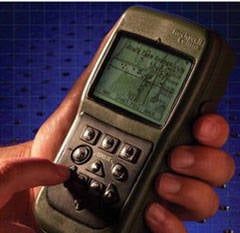 GPS navigator DAGR. Photo: US ARMY.
GPS navigator DAGR. Photo: US ARMY.In August, a new upgraded version of the combat kit was introduced. It has become much lighter than its predecessor and has a number of technical innovations. In particular, now the weight of electronic equipment is 3,2 kilograms, not 4,5 as before. In addition to the GPS-navigator and the helmet-mounted display, the new set is equipped with the Boomerang sniper location system, as well as a more compact keyboard on the control unit.
The new kits can communicate with the Stryker AFV, they can also be used to control robots- sappers.
In July, 2007, the Armed Forces Congressional Committee, released a report identifying the need to continue the implementation of the Land Warrior project. In the defense budget 2008 fiscal year. An amount of 18,7 million dollars was allocated to continue the field test and upgrade the kit.
An interesting fact is that in February 2005, the Land Warrior program was merged with the Future Force Warrior project, which aimed to create a Land Warrior II kit with completely new, “futuristic” technologies. Despite their combination, the Future Force Warrior program is viewed as promising and will be funded even if the Land Warrior project is closed. One of the key elements of the FFW kit will be an exoskeleton suit that provides protection for the soldier and enhances his physical capabilities at the expense of electromechanical “muscles”.
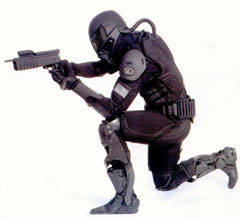 Possible view of Future Force Warrior
Possible view of Future Force WarriorAccording to the military command, the Land Warrior and Mounted Warrior kits during their use in combat conditions in Iraq have significantly increased the awareness of soldiers in urban environments, as well as improved coordination in the performance of combat missions.
At the same time, the soldiers themselves say that the kit is inconvenient, unreliable, and often turns off due to weak batteries. In addition, there are difficulties with the transfer of commands using new electronic equipment. The kit also makes it difficult to make decisions in extreme conditions.
Despite the negative attitude of the soldiers to the new systems, the project is planned to continue, but to increase the number of field trials in real combat operations to identify all the flaws in the new equipment. In general, about 500 million dollars was spent on the project. The estimated cost of one set of Land Warrior is about 70 thousand dollars.
European response to Uncle Sam
Ambitious US programs in the field of individual combat kits initiated the development of similar projects in Germany (IdZ), France (FELIN), Great Britain (FIST), Spain (COMFUT), Sweden (IMESS), Australia (Land 125), etc.
In fact, they all followed the line of American concepts and were focused on the integration of soldiers into the digital battle management system.
France and Germany advanced further than others in this matter. They began to implement their projects almost immediately after the United States - in 1996. The first prototypes of combat kits Germans and French tried to use during the fighting in Yugoslavia. However, they showed their low efficiency - and their funding was discontinued.
The development was resumed when the units of the armed forces of France and Germany were sent to Afghanistan as a large testing ground, which made it possible to determine the main directions for improving the existing developments.
Already in 2003, the French Armed Forces chose Sagem during the tender to finalize the first-generation FELIN-I kit.
FELIN is an abbreviation of "Fantassin a Equipement et Liaisons Integres", which in French means "Integrated equipment and means of infantry communication". According to the contract concluded in 2004, the company must supply 2010 thousands of sets in 22,5 infantry regiments and in addition 20 thousands of sets to armored, engineering and artillery troops before the end of 9.
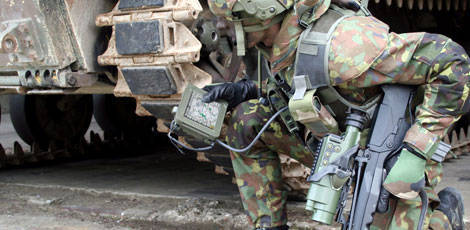
Soldier Included FELIN
50 first prototypes in September 2007 were delivered to the French peacekeeping force stationed in Afghanistan. Delivery of the next batch of 358 test images is scheduled for February 2008. By the end of this year, it is planned to conduct field trials on the basis of three battalions involved in Afghanistan. Deliveries of the first 1000 kits, created as part of full-scale production, are scheduled for the end of 2008. It is expected that by the middle of 2009, two-thirds of the infantry regiments will be equipped with new complexes, and by the 2010 year they will be fully equipped. With 2015, it is planned to begin development of the FELIN-II kit.
The weight of equipment, taking into account electronic equipment (radio, navigation equipment, video and infrared cameras, control unit), weapons, ammunition, helmet, uniforms with body armor and batteries, is about 25 kilograms. The kit will come in five configurations. Each infantry regiment will be equipped with 1000 kits.
The kit included an assault rifle Giat FAMAS G2 caliber 5,56-mm, a Giat sniper rifle FR-F2 caliber 7,62-mm, light machine gun FN Herstal Minimi 5,56-mm caliber. The digital scope of the FAMAS rifle is connected to a mini-monitor on a soldier’s helmet.
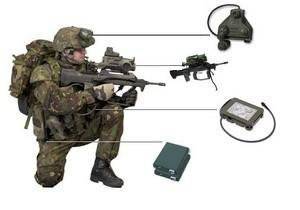 The main components of FELIN
The main components of FELINAs for Germany, at the end of 2006, the Bundeswehr signed a contract worth $ 34,4 million with Rheinmetall Defense Electronics Electronics to develop a second generation IdZ-ES prototype kit with delivery of the first 20 units by May 2007. These kits are already being tested in Afghanistan.
Each IdZ-ES kit provides equipment for an infantry squad of 10 military personnel. The basic version of the IdZ-ES kit weighs only 6,5 kilograms, not counting the ceramic armor, additional equipment and equipment for individual tasks.
IdZ-ES Kit
The abbreviation IdZ means "infantryman of the future" (Infanterist der Zukunft). The kit is a modular design, so the soldier can take only the equipment he needs to perform a specific task. Completion of the development of the new IdZ-ES kit is scheduled for the end of 2008-the beginning of 2009 of the year.
Each IdZ-ES kit provides equipment for an infantry squad of 10 soldiers. One such system includes the following components:
- Bulletproof vest - 10 pcs.
- Unloading vest - 10 pcs.
- VHF-radio for communication with the department - 10 pcs.
- Batteries for VHF-radio - 60 pcs.
- Navigation device - 10 pcs.
- Digital camera - 1 pcs.
- Helmet - 10 pcs.
- Camelback drinking water supply system - 10 pcs.
- Safety glasses - 10 pcs.
- Hearing protection - 10 pcs.
- Protective suit against weapons of mass destruction with mittens and shoe covers - 10 pcs.
- Radiation dosimeter - 10 pcs.
- Laser Rangefinder Vector IV - 1 pcs.
- Light-laser module - 10 pcs.
- Night surveillance device Hunt-IR - 2 pcs.
- Night vision goggles Lucie - 2 pcs.
- Night vision sight NSA80 - 10 pcs.
- Thermal imaging device TWS AN / TAS13A (V) - 2 pcs.
- Submachine gun MP7A1 - 2 pcs.
- 40-mm grenade launcher AG36 - 2 pcs.
- Machine gun MG4 - 2 pcs.
- Large-caliber sniper rifle G82 - 1 thing
The basic weaponry of the kit is the G36 assault rifle.
The G36 assault rifle (automatic) was developed in 1990 for the years by the German company Heckler-Koch and accepted into service in Germany and Spain, and is also offered for export. G36 is built on unconventional for the HC, but the most common in the world (AK-47 ... ... AK-108, for example) the principle of vapor-automatic with locking the barrel by turning the shutter and a short stroke of the gas piston. The rifle uses the modular firing mechanism for weapons of the HC, which is detached when it is not fully disassembled. The fire mode switch has 4 positions - blocking, single fire, 3 shot turns and automatic fire.
Video instruction on incomplete disassembly-assembly, cleaning and lubrication HK G36
The Heckler & Koch MG4 light machine gun has a 5,56 mm caliber, weight and rate of fire, depending on the modification - 7,7-8,1 kg. and 770-880 shots / min. The machine gun has a left-folding plastic stock, a plastic lightweight fore-end and a folding bipod mounted on the gas block. In addition, it provides mounts for installation on equipment or an infantry machine. Sights include a front sight with a folding base and an adjustable quick-release rear sight mounted on a Picatinny rail on the receiver cover. The rear sight is graduated from 100 to 1000 meters, instead of it (or together with it) it is possible to install various day and night sights with standard mounts.
Large-caliber sniper rifle G82 (designed and manufactured by the American company Barrett, slightly adapted by the Bundeswehr for their needs) - Barret M82A1M "Light Fifty" (M82A3 according to the classification of the US Army); caliber: .50 BMG (mm 12.7x99); weight: 12,9 kg (without cartridges); accuracy: 1.5 - 2 MOA (angular minutes) when using match class cartridges.
Real recognition of this rifle began with 1990-91, when, during the preparation and implementation of Operation Desert Storm, the US Armed Forces (first Marine Corps, and then other branches of the military) purchased several hundred MXNXX82 rifles from the company.
These rifles in the troops received the designation SASR - "Special Applications Scoped Rifle", that is, "special-purpose rifle with an optical sight." The main roles for this rifle were the destruction of materiel and combat equipment of the enemy, including automobiles, communications cabins and radars, airplanes and helicopters at the stands. Another important role was the destruction of unexploded ordnance from a safe distance. Weapons of this class are practically not used against individual people.
Currently, Barrett M82A1 rifles are used in more than 30 countries around the world, including Belgium, the UK, Denmark, Italy, Spain, Portugal, Turkey, the United States and other countries.
Beauty among the running ...
Combat kits from other countries, in particular the UK, Spain, Sweden, and Australia are only at the development stage. This is due to the late start of projects in this area. Thus, the UK signed a contract with Thales only in March 2003 of the year, Spain - with the EADS concern in October 2006 of the year, Sweden - at the beginning of 2006 of the year Australia - in 2004 of the year.
Despite their time lag, the field trials of the kits were already scheduled for 2008 year. This is due, first of all, to the reduction of the time it takes to search for conceptual solutions and to develop the necessary technologies. Major developments borrowed from the United States. At the same time, the military are in a hurry to test new kits in real combat conditions against the background of a possible withdrawal of troops from Iraq and Afghanistan.
There are also other programs such as African Warrior (South Africa), Soldato Futuro (Italy), Soldier Modernization Program (Netherlands), NORMANS (Norway), Soldado do Futuro (Portugal), Advanced Combat Man System (Singapore), IMESS (Switzerland ), ANOG (Israel), BEST (Belgium) and 21st Century soldier (Czech Republic).
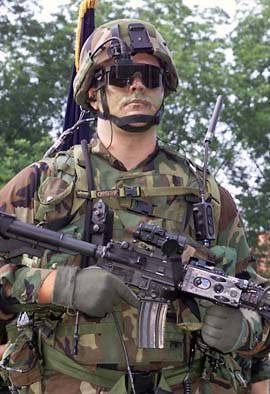 21st Century soldier
21st Century soldier All of them are aimed at raising the situational awareness of soldiers through the use of navigation devices, digital binoculars, electronic maps, various optical and infrared devices, and improved interaction with modern means of communication.
And in our apartment there is gas!
The development of promising equipment for Russian soldiers is carried out within the framework of the relevant federal target program.
Requirements for prospective equipment were developed by the Chief Rocket and Artillery Directorate of the Ministry of Defense (GRAU), with the participation of the relevant structures of other security agencies, as well as specialized research organizations (Central Research Institute "Tochmash", NPO "Spetstekhnika and Svyaz", NPO Spetsmaterialov and others) . The purpose of the program is to create a basic set of individual equipment (BKIE) with the possibility of refinement for various types of tasks. Link to "Tactical technical task for the Barmitsa-Н2 kit" (https://docs.google.com/Doc?id=d2gtck9_2cd56b5gz).
The first model of the BKIE was the Barmitsa kit, which was successfully tested and delivered to the troops. The kit includes an improved 6B7-1М helmet, 6B23-1 body armor, advanced communication equipment and armament - modernized Kalashnikov assault rifles, Pecheneg single machine guns, RPG-29 grenade launchers "Vampire". Initially it was supposed to introduce an AN-94 assault rifle (Abakan) into the kit of prospective equipment, however, the Armed Forces refused this weapon because of its insufficient reliability and complex design.
"Barmitsa"
On the basis of the “Barmitsa” kit, the “Warrior” kit is being developed, which, first of all, will be distinguished by improved communication and navigation equipment. The kit will include the GLONASS system navigator, as well as advanced electronic equipment, providing information exchange and return of orders in accordance with the concept of “battle space”. The development of appropriate equipment is carried out by the concern "Constellation", which has already submitted the first samples of automatic control systems for the connection. Portable GLONASS navigators for the Russian armed forces are being developed by Compass. One of the first models, the NPI navigator, was demonstrated at the MAKS-2007 air show.
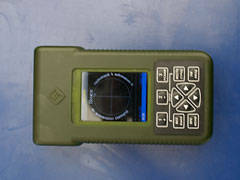 GLONASS Navigator NPI
GLONASS Navigator NPIJust as in the West, the basis of the ACS of the formation is software and hardware complexes for all levels of the hierarchy - from soldier to division commander. The soldier complex is a communicator that provides the transmission of information both by voice and in digital format and displays the tactical situation on the arcuate display. Their complexes are available at all intermediate levels - from the commanders of detachments, platoons, companies, battalions and regiments.
The article used materials from the following sources: the article “Soldiers of the Future” from the site “Lenta.Ru” (http://www.lenta.ru/articles/2008/01/10/warrior/), the branch “Perspective" digital "equipment of the French infantryman FELIN ”from the site RusArmy.com (http://www.rusarmy.com/forum/topic6633.html), the article FELIN is the“ digital kit of the soldier ”from the site Military Informant (http: //www.military-informer. narod.ru/FELIN.htm), description of the FELIN kit from the official website of SAGEM, the site "Modern Small Arms" (http://world.guns.ru/), etc.
The authorship of the main part of the article is unclear - this is either Alexey Sergeyevich Kolentyev, or Nikolai Golovlev and Ilya Kramnik.
PS The representative of the Ministry of Defense said that it would be possible to purchase several sets of FELIN, "for example, eight, for review."
P.P.S What is the point (let's give vent to fantasy?):
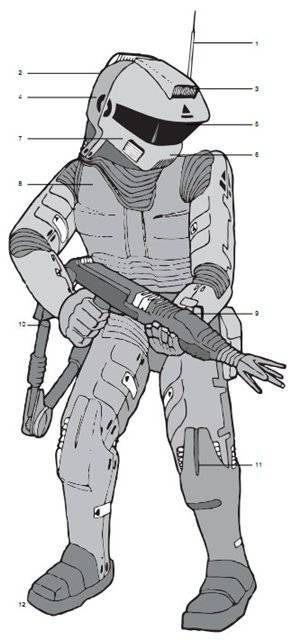 Outfit of a Russian soldier of the second half of the 21 century
Outfit of a Russian soldier of the second half of the 21 century1) telescopic antenna (radio, mobile and satellite communications, etc.);
2) two-part helmet with rear and side view cameras;
3) optical unit (camera, flashlight, IR illuminator, window of the thermal imager, etc.);
4) acoustic device with a decoder that protects against sound overloads;
5) acrylic glass with a sprayed display, auto-dimming;
6) intercom with autotranslator, voice scrambler;
7) integrated gas mask with protection against chemical and biological weapons;
8) quick-hardening intellectual armor with adaptive camouflage and Kevlar lining;
9) railgun or gauss rifle;
10) modular exoskeleton elements;
11) trap, stretch mark and min detection scanner;
12) boots with anti-personnel min.
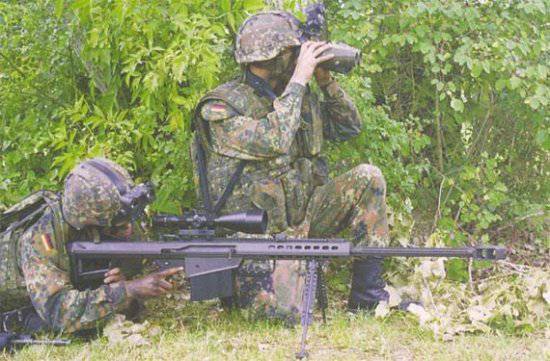
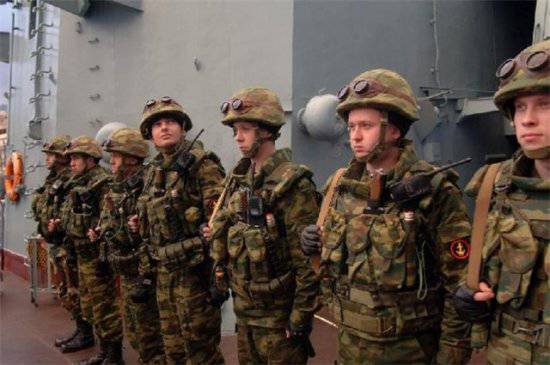
Information